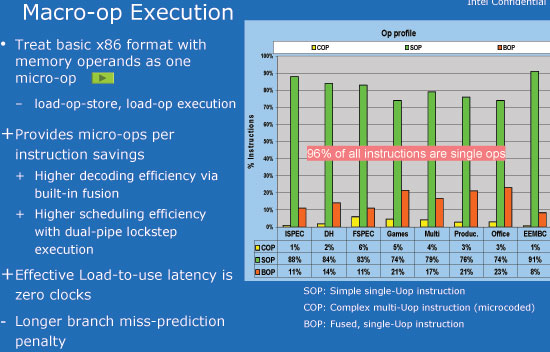Intel's Atom Architecture: The Journey Begins
by Anand Lal Shimpi on April 2, 2008 12:05 AM EST- Posted in
- CPUs
Return of the CISC: Macro-op Execution
The Pentium Pro was Intel's first CPU that finally ended the RISC vs. CISC debates of the early 1990s. To the programmer it was still a x86 CISC machine like every previous Intel processor, but internally once it received its x86 instructions it decoded them into smaller micro-ops to run on a simpler, faster and more efficient RISC core.
By maintaining backwards compatibility with all previous x86 processors Intel was able to leverage one of the major strengths of its CISC architecture (mainly the installed x86 user base) while continuing to evolve by relying on a high performance RISC core.
It turns out that some x86 instructions shouldn't be broken up into smaller micro-ops because they tend to augment each other. With the Pentium M Intel began fusing certain micro-ops into single operations so that they would go down the processor's pipelines atomically, thus saving power and improving efficiency. Intel called this feature micro-op fusion. If two micro-ops were treated as one when going down the pipeline that effectively increased the "width" of the CPU, allowing more instructions to be operated on at once. The internal core was still very much a RISC machine, it was just able to do a little more in certain circumstances.
The Atom takes things one step further and most x86 instructions aren't even broken down into micro-ops internally. As Atom isn't an out-of-order core, it doesn't exactly make sense for it to have tons of micro-ops in flight since it can't reorder them for optimal execution. Furthermore, by keeping most instructions as single operations Intel is able to effectively increase the "width" of Atom.

Instructions that are of the format load-op-store or load-op execution are treated as a single micro-op by Atom's decoder. In other words, if you have an instruction that loads data, operates on it, and stores the result - that's now treated as a single micro-op instead of being broken up into three. The benefit being that there's only a single micro-op that's going down the pipeline, leaving room for another one. Atom may only be a 2-issue architecture, but in certain situations it can behave like a much wider machine.
Intel has spent much of the past decade perfecting its ability to break down x86 instructions into smaller, RISC-like operations and building very high performance cores to deal with these small atomic operations. What's most interesting is that we've now come full circle where in the quest for greater performance per watt Intel is now doing the opposite and not breaking down these x86 instructions in many cases.










46 Comments
View All Comments
lopri - Thursday, April 3, 2008 - link
This article is as much propagana-ish as it is technical. Did you read the last page of the article?clnee55 - Friday, April 4, 2008 - link
Since Anand wrote this article. I let him answer your accusationGulWestfale - Wednesday, April 2, 2008 - link
i believe that the graphics core in the chipset is a powerVR gen5 derivative; intel already uses some of their tech in its existing mainboards and wikipedia states that intel has licensed gen5 tech for one of its chipsets, the GMA500 (which is the same as poulsbo?) gen5 is also DX10-capable, which matches the info in your article.http://en.wikipedia.org/wiki/PowerVR#Series_5_.28S...">http://en.wikipedia.org/wiki/PowerVR#Series_5_.28S...
yyrkoon - Wednesday, April 2, 2008 - link
and wikipedia has been known to be wrong . . . a lot lately it seems.My point here *is*, I would probably trust anandtech more than wikipedia now days, as it seems any Joe can put up a 'reference' without citation.
jones377 - Wednesday, April 2, 2008 - link
Following the references link from the Wiki article...http://www.imgtec.com/News/Release/index.asp?NewsI...">http://www.imgtec.com/News/Release/index.asp?NewsI...
Poulsbo uses a PowerVR 3D core
Anand Lal Shimpi - Wednesday, April 2, 2008 - link
Yep, you guys are correct, I wasn't aware that it was public yet :) I've updated the article.Take care,
Anand